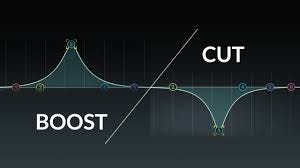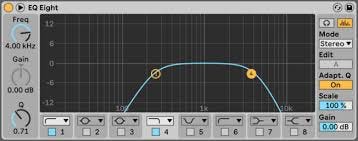Mixing Simplified - EQ 101

The most useful tool that you have in your arsenal for mixing is the all-mighty equalizer (EQ).
It’s also super fun to call it a spectrum processor and imagine your navigating a harmonicraft.
What Is it?
A good analogy for EQ is modeling a sculpture. You can add or subtract material to adjust the overall shape and perception of the piece. Apply this to mixing, and your sculpting sound!
EQ allows you to adjust the various frequencies of a sound, imagine a bunch of mini faders spread across the whole frequency spectrum. You can alter the frequencies in two ways by boosting or cutting.
The goal is to make enough room for all your sounds, remove unnecessary information, and accentuate their shining qualities. You can also use it as a fun, creative tool.
Filter sweeps for dayz.
Whether they are in plug-in (software) or outboard (hardware) form, the principles of EQ are universal. You’ll see these on guitar amps, home studio systems, and even your phone’s audio settings.
EQ’ing Your Tracks
You only have so many frequencies available for all the sounds in a mix, if too many of them overlap, they can start to work against each other. This is called masking and often results in a muddy mix. Alternatively, the best qualities of a sound can be enhanced to make it heard and bring out its character.
Boost and cut, increases or decreases the level of a band of frequencies around a center point; the point at which the most change occurs. This is achieved by adjusting the amount of gain. Adjacent frequencies are also affected but by gradually lesser amounts.

This type of adjustment is often called a bell curve. Useful for affecting specific frequencies or super surgical adjustments.

Q adjusts the “spread” of the affected area. It represents the number of octaves it affects. Lower numbers affect larger ranges of frequencies than higher numbers do.
Shelving also adjusts frequencies, but with a different shape. It has less of a peak and more a more sharp cutoff curve. In this case, adjacent frequencies are equally affected.

This type of adjustment is often called a shelf. Useful for affecting many neighboring frequencies and more smooth adjustments. I usually use high shelf boosts on lead vocals and occasionally on drum overheads.
Filtering removes all frequencies above or below a certain point. High-pass (low-cut) filter (HPF) removes everything below a certain point; low-pass (high-cut) filter (LPF) removes everything above a certain point.

Filters are extremely useful to clean up sounds and your overall mix. I use it on pretty much every track and remove all the necessary sonic information.
The overall goal is to make sure all your sounds are working together and supporting each other in creating a smooth and exciting sonic experience.
The EQ Mindset
Guideline #1 — USE YOUR EARS. I can’t stress this enough. One of the most useful pieces of advice I can give you is to use your ears, not your eyes, to make adjustments.
No one will ever see (unless they get a hold of your session files) or care how your EQ curves might look, what kind you used, what techniques you employed.. All that matters is how it sounds and affects the listener.
EQ has no predetermined way to be used. It is completely dependent on the qualities of a sound at its source, and the goal behind the adjustment.
First and foremost consider the different things that can affect the sound. For example, with guitar: What’s it made of? Acoustic or electric? What kind of strings? Played with a pick or fingers? Plucked or strummed? Heavy of light-handed? Fret sounds? What kind of microphone? What kind of room? What kind of song? Where is it placed in the mix?
That’s a lot of variables, without including the most important one; your personal taste.
EQ — How Much, Where, When and Why?
With this mindset, the best way to approach EQ is for you to know the frequency ranges of the sounds involved. Know the core audible frequency of each sound and how each subsequent octave is contributing to the overall sound.
Click Here → To Download the EQ Blueprint Cheat Sheet
Always listen to the sound in context with everything else in the mix. You should have a good idea of what you want to achieve before starting to tweak and fiddle things into oblivion.
I’ve gone down that rabbit hole countless times, where after hours of adjusting, nothing sounds better… just different.
Have a clear vision of the final mixdown, and decide whether EQ is even needed on particular sounds.
Being mindful of the goal and purpose of each EQ move will maintain perspective on why you're doing something in relation to the entire mix. It will also help you develop a strategy in your approach towards tackling the different steps in the overall mix.
Keep in mind:
1 — EQ affects a sounds harmonic structure.
2 — Very few people can perceive a change in 1dB or less.
3 — EQ should not be a substitute for the quality of the sound source and mic placement.
4 — Be careful in boosting too many unpleasant mid-range and high-end frequencies, they can become very harsh sounding.
5 — Be cognisant of cumulative EQ; Boosting or cutting tracks in the same frequency range have an accumulative effect and too much can unbalance the overall blend.
6 — Subtractive EQ is useful for removing the unwanted qualities of a sound. Sweep the frequency spectrum with highly boosted X Q to find the trouble frequency and then cut it appropriately.
7 — HPF and LPF should be used on all sounds on the frequencies above and below its frequency range. Removing unnecessary sonic information can greatly improve the clarity and definition of a sound. However, be careful not to remove the elements that are essential to the sonic timbre of the sound.
8 -Limit your adjustments while listening to something in SOLO. The sounds of individual tracks might have to be changed to sound unpleasant by themselves but sound amazing in the context of the whole mix.
9 — EQ adjustments between 400Hz and 2000Hz will be more noticeable than other frequencies. This is due to our human ear, which has a heightened perception in this frequency range. Also called the equal loudness principle.
10 — Take regular breaks, this will not only refocus your perception of the mix but allow your ears to rest. Ear fatigue is a real thing. Try to mix at lower volumes for optimal results.
EQ Lingo
There are all sorts of terms that we use to try and describe sonic characteristics to one another.
I personally love the concepts that we’ve developed to attempt to describe the qualities of a sound. Hopefully, this can help you translate the sonic into the verbal.
20–50 Hz — “Rumble” zone. You need a subwoofer or full-range loudspeaker to reproduce it. “Boomy” is when there’s too much energy in this range. Be ultra-careful in this range as it does not take much for it to eat up headroom.
60–80Hz — Boosting here can add “punch” or “impact”. “Size” and “power”. Too much can also be “boomy”
200–300Hz — A lack in the range can sound “thin”, too much can sound “muddy”, particularly in the bass.
500Hz — Boosting here can make something sound “fat” or “warm”, too much can sound “boxy” or “muddy”
Low-frequency roll-off — “thins” sound. This can make things sound “clearer” and “cleaner” but too much can sound “weak” or “tinny”
500–7kHz — Boosting can add “punch”, “presence”, “clarity” or “definition”. It can also make it sound “tinny”, “nasally”, “honky”, “piercing”, “twangy” or “sibilant”. Too much boost can make a mix sound “harsh” or “stiff”.
7kHz-10kHz — Can enhance sound and make it “bright”, “crisp”, “sizzle” or reduce it by making it “edgy”, “glassy”, or “harsh”.
10kHz and above — boosting can “open”, make it “airy”, “transparent”, “detailed”. Too much can be “brittle” or “noisy”
High-frequency roll-off — “mellows”, or “smooths” sound, too much can make it “dull”, “muffled” or “distanced.
Interested in learning more? Click here to download your Mindset Map and discover your next steps in your musical journey.
My name is Alexandre Joyal. I help music creators achieve success with their music by teaching them how to produce themselves and adopt a creative mindset.

